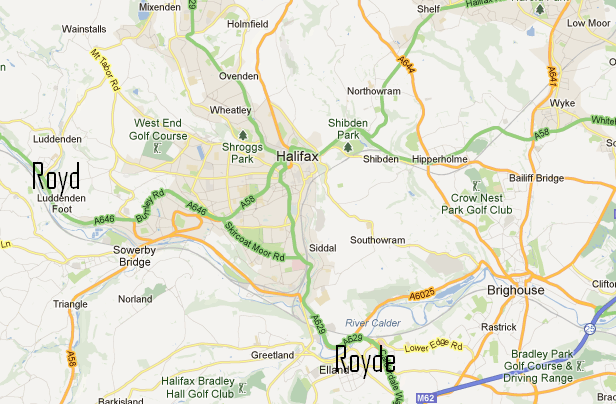The Boggarts of Royde and Royd May 14, 2013
Author: Beach Combing | in : Contemporary, Modern , trackbackToday, an almighty confusion of boggarts: the fairy-shape-shifting-ghosts that haunt the south Pennines and the North West of England. Ellen Royde is a gentile house, now used as a health clinic, in the Lower Calder Valley at Elland near Halifax. There, in the garden, was a boggart chair, some kind of seat or structure, suggesting that the house was fey. Boggart chairs are not particularly common in boggart lore, in fact, we’ve found only one other example. The second boggart chair is to be found at nearby Midgley, in the Upper Calder Valley, where there was also a house with a boggart chair in the garden. Thanks to the spitefulness of time this chair is no longer in the garden either. In fact, it is in a church down the road at Luddenden Foot. A boggart’s anything in a church might sound pretty shocking, but actually the Midgley boggart chair was originally a baptismal font… Then, there is another detail that Beach cannot let pass. The house in Midglely is called Ellen Royd (without an ‘e’). At this point you might want to read this paragraph again to try and make sense of it. Beach’ll be doing his bit for clarity by calling the two houses Royde and Royd from now on.
A fuller and more capable examination of this interesting boggart case is to be found at Lowercalderlegends (written by Kai Roberts, northern folklorist). As the author notes there must be some form of confusion here: Ellen Royd/Royde includes two common northern placename elements, and there is another Ellen Royde at nearby Northowram and traces of one in Halifax. Either a journalist or a historian, deliberately or accidentally, confused the two locales and a legend from one got transferred to the other. The easiest way to establish priority would be to look for the earliest reference to the boggart chair legend in print and go from there. The problem is that the earliest we’ve found in from the 1970s and relates to Midgley. Failing that the Boggart Chairs themselves will be decisive: i.e. the physical piece of stone. Which is more convincing in this role? The fact that the Midgley stone is in a local church means that at least we can be certain that there was a chair there: though having said that the chain of custody from Ellen Royd to said church does not appear to be documented. The lack of any trace of a boggart’s chair at Ellen Royde, meanwhile, is hardly a vote in its favour.
Beach was going to pass the crown up the valley to Midgley on this basis. But at lowercalderlegends one reader, who lived at Ellen Royde in the late 1950s wrote:
I don’t remember the [boggart] stone, but my sister, who is 2 years older than me does remember it. She says there was a bou[l]der like an island in the middle of the lawn and we used to play on it as children. She thinks there was some earth on the top so that it was easy to climb up to it and sit or stand on the top.
If this information is trustworthy, then the legend was at Royde already in the 1950s. It also suggests that a writer’s mistake had entered local or at least family folklore: or did every house have its boggart and this was just ‘another’ boggart stone? For our money the font story from Midgley sounds more credible and Midgley is in a wilder more boggart-like landscape, but that is a long way from proof. Can anyone come closer to resolving this? drbeachcombing AT yahoo DOT com
So far Beach has just revisited details taken from lowercalderlegends and Kai’s research. Now for some new facts. First, by great good fortune Beach has an acquaintance who used to work at Royde in the 1970s. She can remember nothing about any ‘boggarts’ – in fact, she wasn’t absolutely sure what the word meant – but she does know that there were problems keeping cleaners there. No one ever saw anything but at night (were they cleaning then?) the upper floor was ‘sinister’. It is an old house dating back to the late seventeenth century, so there is perhaps no need to connect any of this to boggarts. However, in the interests of more information…
Second, another of Kai’s readers, who lived at Royd in the 1980s and 1990s, has this to say about the house:
if you walk into the churchyard, oppposite the Lord Nelson pub where Branwell [of Bronte fame] drank, look to the left of the gate, and you will see the tombstone of ‘William Oddy of Boggart House’. It only got renamed ‘Ellen Royd’, we think, once the tannery house (which it was) got gentrified.
Beach has no idea what the tannery house is or when it was built but he has found a death record from Ellen Royd, Luddenden Foot from 1881. There were lots of boggart houses in the South Pennines, perhaps there is yet more confusion here? A trawl through the censuses would prove decisive, but it is a busy morning…



